INSTITUT SUPERIEUR D'ANTHROPOLOGIE
INSTITUTE OF ANTHROPOLOGY
ONLINE COURSES / COURS A DISTANCE
DEBUT COURS : AVRIL 2023
REGISTER NOW
ANGLETERRE–  Olney - Archaeologists have uncovered what they believe are the remains of a Roman villa and bath house under land earmarked for a supermarket. The discovery, which features mosaic brickwork, were found in Warrington Road in Olney, Buckinghamshire. The dig was commissioned due to the site's proximity to the existing Roman Site at Olney. Archaeologists said the mosaic featured "vibrant colours and intricate decorative patterns" made up of red, white and blue tiles.
Olney - Archaeologists have uncovered what they believe are the remains of a Roman villa and bath house under land earmarked for a supermarket. The discovery, which features mosaic brickwork, were found in Warrington Road in Olney, Buckinghamshire. The dig was commissioned due to the site's proximity to the existing Roman Site at Olney. Archaeologists said the mosaic featured "vibrant colours and intricate decorative patterns" made up of red, white and blue tiles.
https://www.bbc.com/news/uk-england-beds-bucks-herts-64918113
ANGLETERRE – 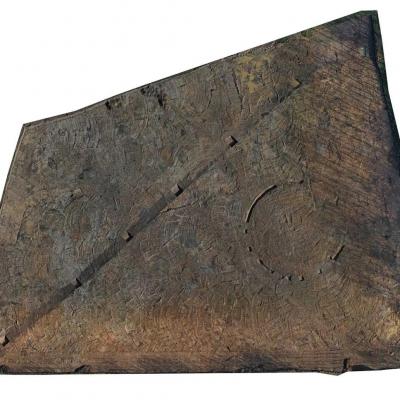 Dove valley - Evidence of archaeological features were first identified from cropmarks and aerial photographs, suggesting the presence of several ring ditches and linear ditches. Excavations have confirmed the existence of the features through a process of trial trenches, where archaeologists conducted a strip, map and sample excavation to fully reveal and investigate the remains. Ring ditches are typically a trench of circular or penannular plan cut into bedrock. The term is most often used as a generic description in cases where there is no clear evidence for the function of the site: for instance where it has been ploughed flat and is known only as a cropmark or a geophysical anomaly. Excavations suggest that the ring ditch is prehistoric in origin, with a similar feature excavated in the vicinity during the 1990’s dating from the Bronze Age. Archaeologists have interpreted the site as a stock enclosure, an ancient pound for the accommodation of livestock. The study has revealed a possible entrance to the enclosure, with evidence of re-cutting of the ring ditch that suggests maintenance of the site and possible longevity of use. The long linear ditch is believed to be a post-medieval boundary for the demarcation of land, running west–east to the north of the ring ditch.
Dove valley - Evidence of archaeological features were first identified from cropmarks and aerial photographs, suggesting the presence of several ring ditches and linear ditches. Excavations have confirmed the existence of the features through a process of trial trenches, where archaeologists conducted a strip, map and sample excavation to fully reveal and investigate the remains. Ring ditches are typically a trench of circular or penannular plan cut into bedrock. The term is most often used as a generic description in cases where there is no clear evidence for the function of the site: for instance where it has been ploughed flat and is known only as a cropmark or a geophysical anomaly. Excavations suggest that the ring ditch is prehistoric in origin, with a similar feature excavated in the vicinity during the 1990’s dating from the Bronze Age. Archaeologists have interpreted the site as a stock enclosure, an ancient pound for the accommodation of livestock. The study has revealed a possible entrance to the enclosure, with evidence of re-cutting of the ring ditch that suggests maintenance of the site and possible longevity of use. The long linear ditch is believed to be a post-medieval boundary for the demarcation of land, running west–east to the north of the ring ditch.
https://www.heritagedaily.com/2023/03/archaeologists-uncover-ancient-ring-ditch/146558
FRANCE –  Reims - Reims, ancienne Durocortorum au temps de la Gaule belge, est un terrain de jeu idéal pour l’archéologie. Des dizaines de chantiers de fouilles s’y sont succédé ces dernières années. Dernier chantier de fouille en date, celui autour de la Porte de Mars, l’un des plus grands arcs gallo-romains encore debout en Europe. Ici, les archéologues de l’Inrap viennent de mettre au jour un site d’habitat monumental et luxueux de l’époque antique. Il se caractérise par deux galeries à portique formant un U et une vingtaine de pièces qui s’organisent autour. « On s’attend toujours à trouver des habitations mais là nous avons trouvé un ensemble de bains antiques daté des IIe et IIIe siècle après J.C. On ne sait pas encore si c’est une grande domus ou des thermes publics », explique Yoann Rabasté. Même si la présence d’une dizaine d’hypocaustes peuvent orienter les archéologues. Cet ancêtre du système de chauffage au sol, constitué de petites tuiles, permet de faire circuler l’air chaud. Sa présence en nombre peut laisser présager d’un ensemble thermal. Des céramiques, des mosaïques mais aussi des enduits peints, de près de 2000 ans, ont également été mis au jour. Yoann Rabasté dévoile une première fresque florale cachée par une large bâche étanche, : «Sur celle-ci, on visualise bien la feuille d’acanthe et les différents pigments de couleurs utilisés, éclaire l’archéologue. C’est très rare comme vestige et sur ce chantier, les fresques ont été très bien conservées ». Jusque mi-juin, onze archéologues et un topographe seront encore à pied d’œuvre.
Reims - Reims, ancienne Durocortorum au temps de la Gaule belge, est un terrain de jeu idéal pour l’archéologie. Des dizaines de chantiers de fouilles s’y sont succédé ces dernières années. Dernier chantier de fouille en date, celui autour de la Porte de Mars, l’un des plus grands arcs gallo-romains encore debout en Europe. Ici, les archéologues de l’Inrap viennent de mettre au jour un site d’habitat monumental et luxueux de l’époque antique. Il se caractérise par deux galeries à portique formant un U et une vingtaine de pièces qui s’organisent autour. « On s’attend toujours à trouver des habitations mais là nous avons trouvé un ensemble de bains antiques daté des IIe et IIIe siècle après J.C. On ne sait pas encore si c’est une grande domus ou des thermes publics », explique Yoann Rabasté. Même si la présence d’une dizaine d’hypocaustes peuvent orienter les archéologues. Cet ancêtre du système de chauffage au sol, constitué de petites tuiles, permet de faire circuler l’air chaud. Sa présence en nombre peut laisser présager d’un ensemble thermal. Des céramiques, des mosaïques mais aussi des enduits peints, de près de 2000 ans, ont également été mis au jour. Yoann Rabasté dévoile une première fresque florale cachée par une large bâche étanche, : «Sur celle-ci, on visualise bien la feuille d’acanthe et les différents pigments de couleurs utilisés, éclaire l’archéologue. C’est très rare comme vestige et sur ce chantier, les fresques ont été très bien conservées ». Jusque mi-juin, onze archéologues et un topographe seront encore à pied d’œuvre.
A Reims, un ensemble thermal gallo-romain a été découvert près de la Porte-de-Mars (msn.com)
CHINE – 

 Lianhua’ao Island - Dongting Lake shriveled under a record-breaking severe drought over the summer of 2022. While doing a field survey on one of Dongting Lake’s islands, local authorities stumbled upon the ruins of an ancient tomb. They alerted cultural authorities who sent archaeologists to investigate the find. Archaeologists excavated the site on Lianhua’ao Island and uncovered nine tombs and five ash pits, officials said. The tombs had a rectangular design, long and skinny, with some graves placed side-by-side. The burial site was poorly preserved but still held a few treasures, archaeologists said. Stone axes from the Neolithic age were unearthed. Photos show the worn-down stone tools. The Neolithic age began in about 10,000 B.C., according to Britannica. The Lianhua’ao Island site and its weathered tombs were at least 12,000 years old, archaeologists said in the release. Archaeologists found porcelain from the Tang and Song dynasties. These dynasties ruled China in close succession beginning in 618 A.D. and continuing until 1279, according to Britannica. Photos show the white fragments of several bowls decorated with a delicate, pale blue design. Blue-green pottery from the Ming and Qing dynasties was also uncovered, the release said.
Lianhua’ao Island - Dongting Lake shriveled under a record-breaking severe drought over the summer of 2022. While doing a field survey on one of Dongting Lake’s islands, local authorities stumbled upon the ruins of an ancient tomb. They alerted cultural authorities who sent archaeologists to investigate the find. Archaeologists excavated the site on Lianhua’ao Island and uncovered nine tombs and five ash pits, officials said. The tombs had a rectangular design, long and skinny, with some graves placed side-by-side. The burial site was poorly preserved but still held a few treasures, archaeologists said. Stone axes from the Neolithic age were unearthed. Photos show the worn-down stone tools. The Neolithic age began in about 10,000 B.C., according to Britannica. The Lianhua’ao Island site and its weathered tombs were at least 12,000 years old, archaeologists said in the release. Archaeologists found porcelain from the Tang and Song dynasties. These dynasties ruled China in close succession beginning in 618 A.D. and continuing until 1279, according to Britannica. Photos show the white fragments of several bowls decorated with a delicate, pale blue design. Blue-green pottery from the Ming and Qing dynasties was also uncovered, the release said.
https://www.kansascity.com/news/nation-world/world/article273246720.html#storylink=mainstage_lead
PEROU – 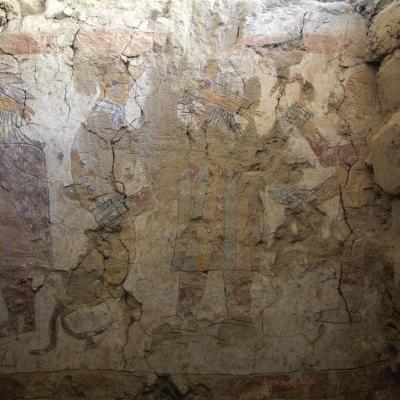
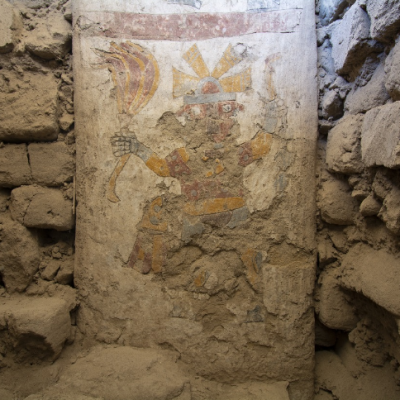
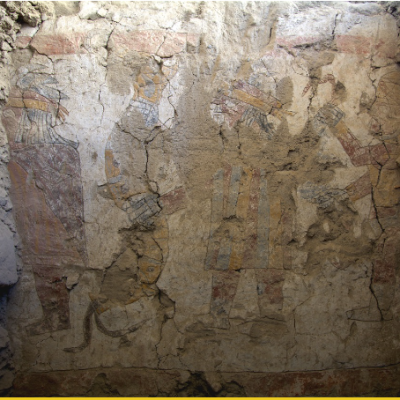
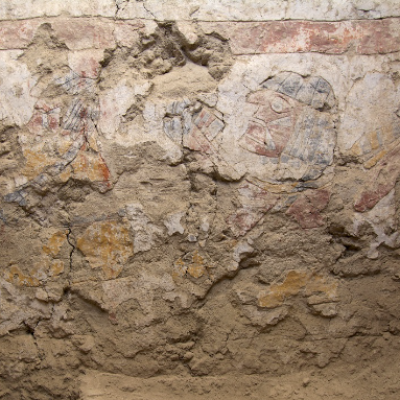 Pañamarca - Excavations conducted at the archaeological site of Pañamarca, an architectural complex constructed between AD 550-800 in the Peruvian Ancash region’s lower Nepeña Valley, have revealed adobe walls decorated with 1,400-year-old murals. Murals painted on a pillar depicts two-faced figures, one of which is shown holding a feather fan and a goblet with four hummingbirds, while the other figure is holding a feather fan and staff. Other murals have been uncovered in various states of preservation showing individual figures, or one scene that depicts multiple figures standing alongside an anthropomorphic serpent. Pañamarca was a place of remarkable artistic innovation and creativity, with painters elaborating on their knowledge of artistic canons in creative and meaningful ways as the people of Nepeña established their position in the far southern Moche world. The team has proposed that the mural paintings — together with the evidence of highland-style textiles and tropical feathers found alongside locally-made ceramics and material culture in the excavations — suggest multicultural relationships and long-distance economies. The Moche culture, also known as the Mochica culture, is an ancient Andean civilisation that flourished from the 1st to the 8th century AD on the northern coast of Peru.
Pañamarca - Excavations conducted at the archaeological site of Pañamarca, an architectural complex constructed between AD 550-800 in the Peruvian Ancash region’s lower Nepeña Valley, have revealed adobe walls decorated with 1,400-year-old murals. Murals painted on a pillar depicts two-faced figures, one of which is shown holding a feather fan and a goblet with four hummingbirds, while the other figure is holding a feather fan and staff. Other murals have been uncovered in various states of preservation showing individual figures, or one scene that depicts multiple figures standing alongside an anthropomorphic serpent. Pañamarca was a place of remarkable artistic innovation and creativity, with painters elaborating on their knowledge of artistic canons in creative and meaningful ways as the people of Nepeña established their position in the far southern Moche world. The team has proposed that the mural paintings — together with the evidence of highland-style textiles and tropical feathers found alongside locally-made ceramics and material culture in the excavations — suggest multicultural relationships and long-distance economies. The Moche culture, also known as the Mochica culture, is an ancient Andean civilisation that flourished from the 1st to the 8th century AD on the northern coast of Peru.
https://www.heritagedaily.com/2023/03/ancient-murals-depicting-two-faced-figures-found-in-peru/146551
BELIZE –  Yok Balum - Classic Maya populations living in peri-urban states were highly dependent on seasonally distributed rainfall for reliable surplus crop yields. Despite intense study of the potential impact of decadal to centennial-scale climatic changes on the demise of Classic Maya sociopolitical institutions (750-950 CE), its direct importance remains debated. We provide a detailed analysis of a precisely dated speleothem record from Yok Balum cave, Belize, that reflects local hydroclimatic changes at seasonal scale over the past 1600 years. We find that the initial disintegration of Maya sociopolitical institutions and population decline occurred in the context of a pronounced decrease in the predictability of seasonal rainfall and severe drought between 700 and 800 CE. The failure of Classic Maya societies to successfully adapt to volatile seasonal rainfall dynamics likely contributed to gradual but widespread processes of sociopolitical disintegration. We propose that the complex abandonment of Classic Maya population centres was not solely driven by protracted drought but also aggravated by year-to-year decreases in rainfall predictability, potentially caused by a regional reduction in coherent Intertropical Convergence Zone-driven rainfall.
Yok Balum - Classic Maya populations living in peri-urban states were highly dependent on seasonally distributed rainfall for reliable surplus crop yields. Despite intense study of the potential impact of decadal to centennial-scale climatic changes on the demise of Classic Maya sociopolitical institutions (750-950 CE), its direct importance remains debated. We provide a detailed analysis of a precisely dated speleothem record from Yok Balum cave, Belize, that reflects local hydroclimatic changes at seasonal scale over the past 1600 years. We find that the initial disintegration of Maya sociopolitical institutions and population decline occurred in the context of a pronounced decrease in the predictability of seasonal rainfall and severe drought between 700 and 800 CE. The failure of Classic Maya societies to successfully adapt to volatile seasonal rainfall dynamics likely contributed to gradual but widespread processes of sociopolitical disintegration. We propose that the complex abandonment of Classic Maya population centres was not solely driven by protracted drought but also aggravated by year-to-year decreases in rainfall predictability, potentially caused by a regional reduction in coherent Intertropical Convergence Zone-driven rainfall.
https://www.nature.com/articles/s43247-023-00717-5
TURQUIE – 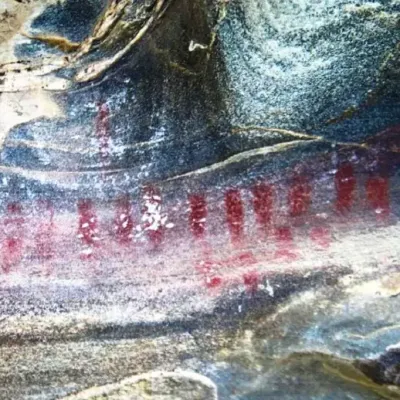 Latmos - New paintings believed to be from the prehistoric era have come to light during the ongoing studies on Mount Latmos (Beşparmak), home to significant rock paintings from ancient times. The main subject of Latmos rock paintings, which have unique features in terms of subject and style, is related to the relationship between men and women, family, spring festivals and wedding ceremonies. In many paintings, decorations and figures resembling weaving patterns are also seen.
Latmos - New paintings believed to be from the prehistoric era have come to light during the ongoing studies on Mount Latmos (Beşparmak), home to significant rock paintings from ancient times. The main subject of Latmos rock paintings, which have unique features in terms of subject and style, is related to the relationship between men and women, family, spring festivals and wedding ceremonies. In many paintings, decorations and figures resembling weaving patterns are also seen.
https://www.hurriyetdailynews.com/exciting-discovery-in-latmos-181517
FRANCE – Blois - Nous avons réalisé un modèle 3D des fouilles archéologiques de l'îlot Saint-Vincent à Blois à partir de prises de vue aériennes réalisées par drone. Plusieurs centaines d'images ont été utilisées dans ce cadre avec une précision de positionnement de l'ordre du centimètre. Ce modèle permet de se déplacer à l'intérieur du chantier, de zoomer sur une partie et de réaliser des mesures (distance, surface, volume).
VIDEO = https://www.youtube.com/watch?v=6LV7l2qePVw
GUATEMALA –  Mirador-Calakmul Karst Basin - In a new study published in the journal Ancient Mesoamerica, researchers from Texas-based universities used LiDAR, or laser-based imaging, to open up more of Maya settlement history than ever known before. The light detection and ranging technology pierced through the heavily forested Mirador-Calakmul Karst Basin in northern Guatemala to show that more than 1,000 settlements covered about 650 square miles, all connected with 110 miles of causeways that the Maya people used to travel their settlements, cities, and cultural centers. The researchers even located canals and reservoirs, highlighting the expanse of the organization from the Maya culture in the middle and late preclassic period from about 1000 BC to 150 AD. The concentration of preclassic Maya sites connected by causeways forms a "web of implied social, political, and economic interactions," according to the study: "Monumental architecture, consistent architectural formats, specific site boundaries, water management/collection facilities, and 177 kilometers (110 miles) of elevated preclassic causeways suggest labor investments that defy organizational capabilities of lesser polities and potentially portray the strategies of governance in the preclassic period." The study authors tell Live Science that for the Mayans, the area provided a mix of ideal living conditions for structures while still offering agricultural lowlands. Researchers believe that uncovering such a vast array of the Maya civilization shows off just how involved and interconnected the culture was. "Settlement distributions, architectural continuities, chronological contemporaneity, and volumetric considerations of sites provide evidence for early centralized administrative and socio-economic strategies within a defined geographical region," the study says.
Mirador-Calakmul Karst Basin - In a new study published in the journal Ancient Mesoamerica, researchers from Texas-based universities used LiDAR, or laser-based imaging, to open up more of Maya settlement history than ever known before. The light detection and ranging technology pierced through the heavily forested Mirador-Calakmul Karst Basin in northern Guatemala to show that more than 1,000 settlements covered about 650 square miles, all connected with 110 miles of causeways that the Maya people used to travel their settlements, cities, and cultural centers. The researchers even located canals and reservoirs, highlighting the expanse of the organization from the Maya culture in the middle and late preclassic period from about 1000 BC to 150 AD. The concentration of preclassic Maya sites connected by causeways forms a "web of implied social, political, and economic interactions," according to the study: "Monumental architecture, consistent architectural formats, specific site boundaries, water management/collection facilities, and 177 kilometers (110 miles) of elevated preclassic causeways suggest labor investments that defy organizational capabilities of lesser polities and potentially portray the strategies of governance in the preclassic period." The study authors tell Live Science that for the Mayans, the area provided a mix of ideal living conditions for structures while still offering agricultural lowlands. Researchers believe that uncovering such a vast array of the Maya civilization shows off just how involved and interconnected the culture was. "Settlement distributions, architectural continuities, chronological contemporaneity, and volumetric considerations of sites provide evidence for early centralized administrative and socio-economic strategies within a defined geographical region," the study says.
https://www.popularmechanics.com/science/archaeology/a43328150/scientists-find-hidden-mayan-civilization/
ARABIE SAOUDITE – 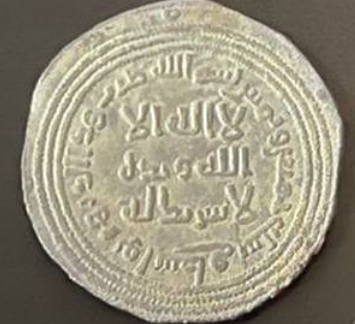 Halit - Saudi Arabia's Heritage Commission announced on Wednesday that an Umayyad coin dating to the year 85 AH has been discovered in the Halit archaeological site in Dawadimi Province in Riyadh.The Heritage Commission said the recent discoveries confirm the importance of the site as one of the most important mining settlements, which was of high importance in the early Islamic era. During the excavation, finds included a mithqal, used for measuring precious metals, early Arabic writing and a “settlement market”, featuring adjoining rooms with side entrances next to a mosque, which was also recently discovered. The Halit archaeological site highlights the role of the Arabian Peninsula during the Umayyad period and has an integrated structure.,The site was earlier called Maadan Al Najadi and belonged to the sons of Najad bin Musa bin Saad bin Abi Waqqas.
Halit - Saudi Arabia's Heritage Commission announced on Wednesday that an Umayyad coin dating to the year 85 AH has been discovered in the Halit archaeological site in Dawadimi Province in Riyadh.The Heritage Commission said the recent discoveries confirm the importance of the site as one of the most important mining settlements, which was of high importance in the early Islamic era. During the excavation, finds included a mithqal, used for measuring precious metals, early Arabic writing and a “settlement market”, featuring adjoining rooms with side entrances next to a mosque, which was also recently discovered. The Halit archaeological site highlights the role of the Arabian Peninsula during the Umayyad period and has an integrated structure.,The site was earlier called Maadan Al Najadi and belonged to the sons of Najad bin Musa bin Saad bin Abi Waqqas.
https://www.thenationalnews.com/gulf-news/2023/03/15/saudi-heritage-commission-finds-rare-umayyad-coin-from-early-islamic-era/
THAILANDE –  Nong Khai - A Buddhist stupa has emerged in the middle of the Mekong River, which demarcates the border between Thailand and Laos, in the Thai province of Nong Khai. Known as the Phra That Klang Nam stupa, the monument is estimated to be more than 700 years old. Originally built on the bank of the river, the stupa toppled into the Mekong in 1847 and has since been under water. According to the traditional Buddhist chronicle Urangkhathat (Phrathat Phanom), which provides a history of the shrine and the relics within, foot-bone relics of the Buddha are enshrined in the stupa. An underwater archeological survey of the stupa revealed that it is 17.2 meters wide and 28.5 meters tall. The structure is broken into three pieces and continues to be eroded by the flow of water around it.
Nong Khai - A Buddhist stupa has emerged in the middle of the Mekong River, which demarcates the border between Thailand and Laos, in the Thai province of Nong Khai. Known as the Phra That Klang Nam stupa, the monument is estimated to be more than 700 years old. Originally built on the bank of the river, the stupa toppled into the Mekong in 1847 and has since been under water. According to the traditional Buddhist chronicle Urangkhathat (Phrathat Phanom), which provides a history of the shrine and the relics within, foot-bone relics of the Buddha are enshrined in the stupa. An underwater archeological survey of the stupa revealed that it is 17.2 meters wide and 28.5 meters tall. The structure is broken into three pieces and continues to be eroded by the flow of water around it.
https://www.buddhistdoor.net/news/ancient-buddhist-stupa-visible-as-mekong-river-levels-recede-in-thailand/